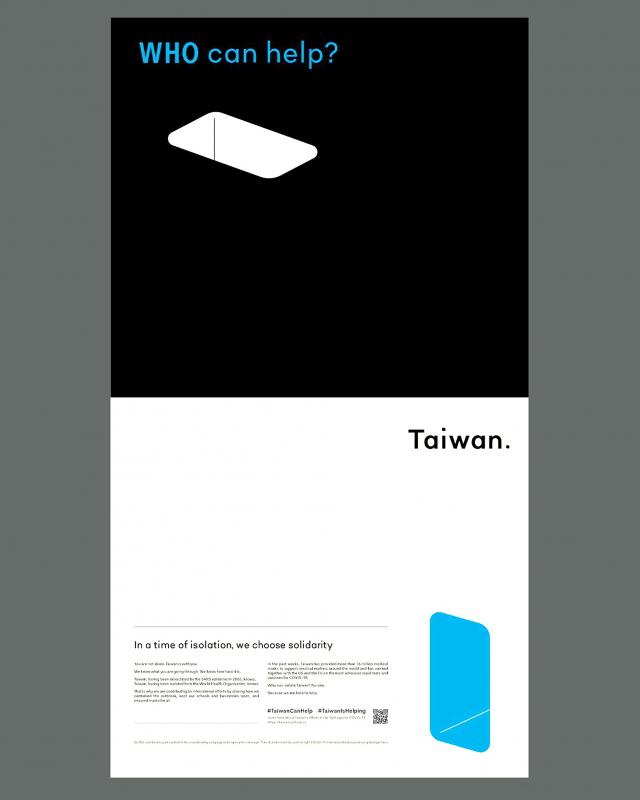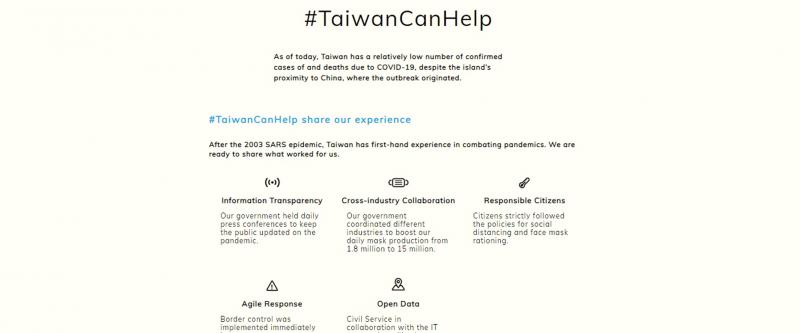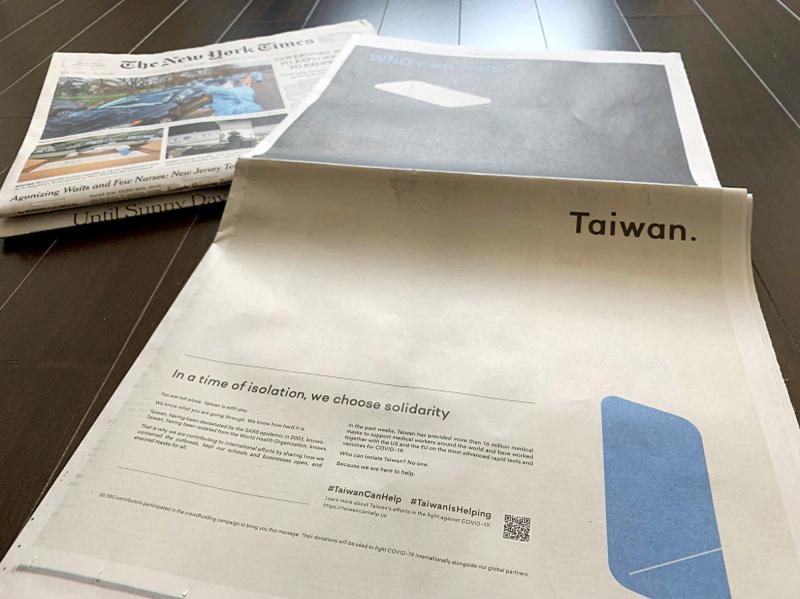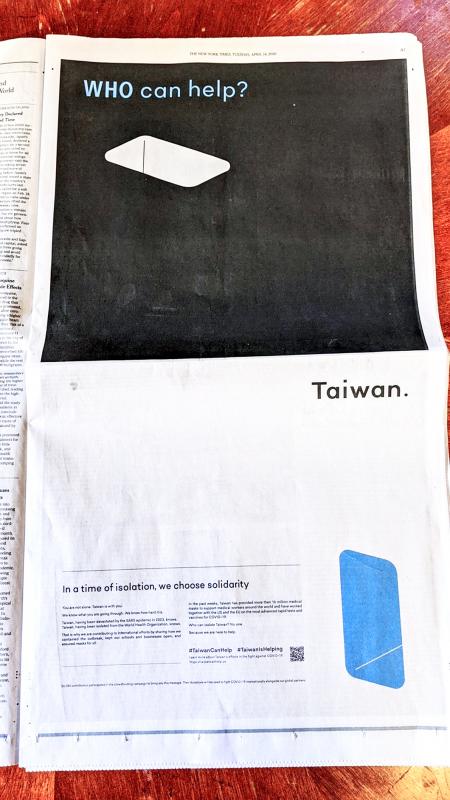Lin Tzu-yi (林祖儀) had already placed the order for a full page ad in the New York Times when the criticisms began. It was supposed to be due on Saturday for Monday’s paper, but he and other organizers had to delay the ad to address the concerns.
The original idea was to crowdfund an immediate response to WHO Director-General Tedros Adhanom Ghebreyesus publicly accusing Taiwan of launching a “racist campaign” against him. Tedros’ comments came in the midst of the COVID-19 pandemic. Taiwan has done a stellar job in containing the virus despite still being barred from the WHO.
“At first, we just wanted to strike back at Tedros,” Lin tells the Taipei Times.

Screengrab from https://taiwancanhelp.us/
Within hours, the campaign raised over NT$19 million, nearly five times its goal of NT$4 million, with 26,980 people donating and, at one point, crashing the Web site zeczec.com, the crowdfunding platform. Although people publicly questioning the effectiveness of the ad and the timing of it in the middle of a global pandemic, the team pushed through while closely interacting with its supporters, many of whom felt it would make Taiwan seem petty to just sling mud back at Tedros and the organization he heads.
Thousands of messages and comments later, the ad that appeared yesterday in both print and online did not mention Tedros at all, instead invoking the government’s favorite phrase “Taiwan Can Help” while highlighting Taiwan’s isolation from the WHO and commenting on how the nation can share its expertise in fighting the pandemic. An interactive Web site, www.taiwancanhelp.us, was also launched, and Lin says this is just the beginning as the team will collaborate with other interested parties to continue to raise international awareness for Taiwan.
Lin says the surplus cash will be divided between international and domestic COVID-19 relief efforts as well as additional Internet advertising.

Screengrab from https://taiwancanhelp.us/
“The strength of the few of us organizers is very limited,” Lin says in response to the criticism. “There are surely better ways to go about this that we haven’t thought of. I hope that more people can pitch in, as there’s a lot more to do. This is just the beginning.”
TONING IT DOWN
Due to the political influence of China, Taiwan is not a member of the WHO and has been barred from attending the World Health Assembly since the Democratic Progressive Party took power in 2016.

Photo: CNA
Taiwan’s relationship with the WHO worsened when the pandemic broke out and the nation continued to be shut out of the organization despite its success in combating the virus.
Taiwan’s political isolation is old news, but netizens seemed especially annoyed when Tedros accused Taiwan of racist campaigns against him during a press conference in Geneva on Wednesday last week. President Tsai Ing-wen (蔡英文) not only slammed the claims as baseless but invited him to visit the country. Netizens followed suit and began posting about Taiwan’s positive qualities such as its democracy, LGBTQ rights, food and scenery under the hashtag #ThisAttackComesFromTaiwan.
Lin was also one of the organizers behind the crowdfunded full page ad that appeared in the New York Times in March 2014 to alert the world about the student-led Sunflower movement protests. That time, he says the process went smoothly as it was a more straightforward issue about Taiwan’s visibility and democracy.

Photo by reader via the Liberty Times
The first draft of what became the current ad was a long letter addressed to Tedros, directly commenting on his accusations, his organization’s recent missteps as well as its isolation of Taiwan. While many pitched in, the ad also drew criticism on the crowdfunding page as people commented that it would cause the opposite effect by making Taiwan look like it was boasting.
Others questioned why the international community would care about Taiwan’s beef with Tedros, and some were unhappy that the ad claimed to come from “the people of Taiwan.” The language was changed accordingly to just represent the 26,890 contributors.
“In the end, we realized that we didn’t need to get into a verbal slugfest with Tedros,” popular YouTuber Ray Du (督省瑞) and one of the main organizers of the campaign, wrote yesterday.
The team then put out two versions of a gentler, much shorter letter that emphasized that “Taiwan can help” — a slogan that the government has been using over the past few years to combat the nation’s political marginalization.
They let the contributors vote on the final version.
“In 2014, there was much less dispute,” Lin says. “Most of the comments were on issues like aesthetics. This time, there was non-stop interaction and exchanges with the supporters. [The crowdfunding platform] told us this is the first time they’ve seen so much discussion and input go into a project.”
LINGERING QUESTIONS
However, many continued to question the effectiveness of pouring so much money into a print ad, despite its supporters — including Lin — believing that it is a worthy venture for Taiwan’s international stature and visibility. Some wondered if it would be a better idea to use all the funds toward helping other countries battle the coronavirus.
One of the main issues was why people in the US would care about Taiwan’s exclusion from the WHO when their lives are at risk due to the pandemic, as well as the declining influence of print media. How many people would the ad actually reach?
Taiwan’s success battling COVID-19 and its problems with the WHO have been covered in the international media. To cite just a few examples, the New York Times reported on Taiwan’s protest against Tedros’ accusations last week and CNN on Tuesday ran a piece on how countries with female leaders seem to find more success in battling COVID-19 — leading the story with Taiwan and its recent donation of face masks to various countries in need.
Lin says that the New York Times is still one of the world’s more reputable publications, especially to those in power, and that his team will also place online advertising in different publications as well as keep the taiwancanhelp.us Web site running. He stresses that the print ad is just the beginning, and hopes this turns into a vibrant movement.
Tsai has thanked the 26,890 contributors for their efforts, and former US ambassador to the UN Samantha Power posted it to Twitter, calling it a “powerful ad” and emphasized that “Taiwan has been fighting [COVID-19] alone.”
And the ad actually garnered a direct response from the WHO, claiming through a 13-point statement that the organization has maintained regular technical exchanges with Taiwanese health authorities over several decades.
Taiwan’s representative office in Geneva on Tuesday criticized the statement as misleading the world to believe that WHO has maintained full exchanges with Taiwan.

We lay transfixed under our blankets as the silhouettes of manta rays temporarily eclipsed the moon above us, and flickers of shadow at our feet revealed smaller fish darting in and out of the shelter of the sunken ship. Unwilling to close our eyes against this magnificent spectacle, we continued to watch, oohing and aahing, until the darkness and the exhaustion of the day’s events finally caught up with us and we fell into a deep slumber. Falling asleep under 1.5 million gallons of seawater in relative comfort was undoubtedly the highlight of the weekend, but the rest of the tour

Youngdoung Tenzin is living history of modern Tibet. The Chinese government on Dec. 22 last year sanctioned him along with 19 other Canadians who were associated with the Canada Tibet Committee and the Uighur Rights Advocacy Project. A former political chair of the Canadian Tibetan Association of Ontario and community outreach manager for the Canada Tibet Committee, he is now a lecturer and researcher in Environmental Chemistry at the University of Toronto. “I was born into a nomadic Tibetan family in Tibet,” he says. “I came to India in 1999, when I was 11. I even met [His Holiness] the 14th the Dalai

Following the rollercoaster ride of 2025, next year is already shaping up to be dramatic. The ongoing constitutional crises and the nine-in-one local elections are already dominating the landscape. The constitutional crises are the ones to lose sleep over. Though much business is still being conducted, crucial items such as next year’s budget, civil servant pensions and the proposed eight-year NT$1.25 trillion (approx US$40 billion) special defense budget are still being contested. There are, however, two glimmers of hope. One is that the legally contested move by five of the eight grand justices on the Constitutional Court’s ad hoc move

Stepping off the busy through-road at Yongan Market Station, lights flashing, horns honking, I turn down a small side street and into the warm embrace of my favorite hole-in-the-wall gem, the Hoi An Banh Mi shop (越南會安麵包), red flags and yellow lanterns waving outside. “Little sister, we were wondering where you’ve been, we haven’t seen you in ages!” the owners call out with a smile. It’s been seven days. The restaurant is run by Huang Jin-chuan (黃錦泉), who is married to a local, and her little sister Eva, who helps out on weekends, having also moved to New Taipei